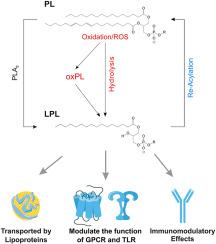Phospholipid-derived lysophospholipids in (patho)physiology
IF 4.9
2区 医学
Q1 CARDIAC & CARDIOVASCULAR SYSTEMS
引用次数: 0
Abstract
Phospholipids (PL) are major components of cellular membranes and changes in PL metabolism have been associated with the pathogenesis of numerous diseases. Lysophosphatidylcholine (LPC) in particular, is a comparably abundant component of oxidatively damaged tissues. LPC originates from the cleavage of phosphatidylcholine (PC) by phospholipase A2 or the reaction of lipids with reactive oxygen species (ROS) such as HOCl. Another explanation of increased LPC concentration is the decreased re-acylation of LPC into PC. While there are also several other lysophospholipids, LPC is the most abundant lysophospholipid in mammals and will therefore be the focus of this review.
LPC is involved in many physiological processes. It induces the migration of lymphocytes, fostering the production of pro-inflammatory compounds by inducing oxidative stress. LPC also “signals” via G protein-coupled and Toll-like receptors and has been implicated in the development of different diseases. However, LPCs are not purely “bad”: this is reflected by the fact that the concentration and fatty acyl composition of LPC varies under different conditions, in plasma of healthy and diseased individuals, in tissues and different tumors.
Targeting LPC and lipid metabolism and restoring homeostasis might be a potential therapeutic method for inflammation-related diseases.

磷脂衍生的溶血磷脂在(病理)生理学中的作用。
磷脂(PL)是细胞膜的主要成分,磷脂代谢的变化与多种疾病的发病机制有关。尤其是溶血磷脂酰胆碱(LPC),它是氧化损伤组织中含量相当丰富的一种成分。溶血磷脂酰胆碱来源于磷脂酶 A2 对磷脂酰胆碱(PC)的裂解或脂质与活性氧(ROS)(如 HOCl)的反应。LPC 浓度升高的另一个原因是 LPC 转化为 PC 的再酰化减少。虽然还有其他几种溶血磷脂,但 LPC 是哺乳动物体内含量最高的溶血磷脂,因此将是本综述的重点。LPC 参与了许多生理过程。它能诱导淋巴细胞迁移,通过诱导氧化应激促进促炎化合物的产生。LPC 还通过 G 蛋白偶联受体和 Toll 样受体发出 "信号",并与不同疾病的发生发展有关。然而,LPC 并不纯粹是 "坏 "的:LPC 的浓度和脂肪酰基组成在不同条件下、在健康人和病人的血浆中、在组织和不同肿瘤中都会发生变化,就反映了这一点。针对 LPC 和脂质代谢以及恢复平衡可能是治疗炎症相关疾病的一种潜在方法。
本文章由计算机程序翻译,如有差异,请以英文原文为准。
求助全文
约1分钟内获得全文
求助全文
来源期刊

Atherosclerosis
医学-外周血管病
CiteScore
9.80
自引率
3.80%
发文量
1269
审稿时长
36 days
期刊介绍:
Atherosclerosis has an open access mirror journal Atherosclerosis: X, sharing the same aims and scope, editorial team, submission system and rigorous peer review.
Atherosclerosis brings together, from all sources, papers concerned with investigation on atherosclerosis, its risk factors and clinical manifestations. Atherosclerosis covers basic and translational, clinical and population research approaches to arterial and vascular biology and disease, as well as their risk factors including: disturbances of lipid and lipoprotein metabolism, diabetes and hypertension, thrombosis, and inflammation. The Editors are interested in original or review papers dealing with the pathogenesis, environmental, genetic and epigenetic basis, diagnosis or treatment of atherosclerosis and related diseases as well as their risk factors.
 求助内容:
求助内容: 应助结果提醒方式:
应助结果提醒方式:


